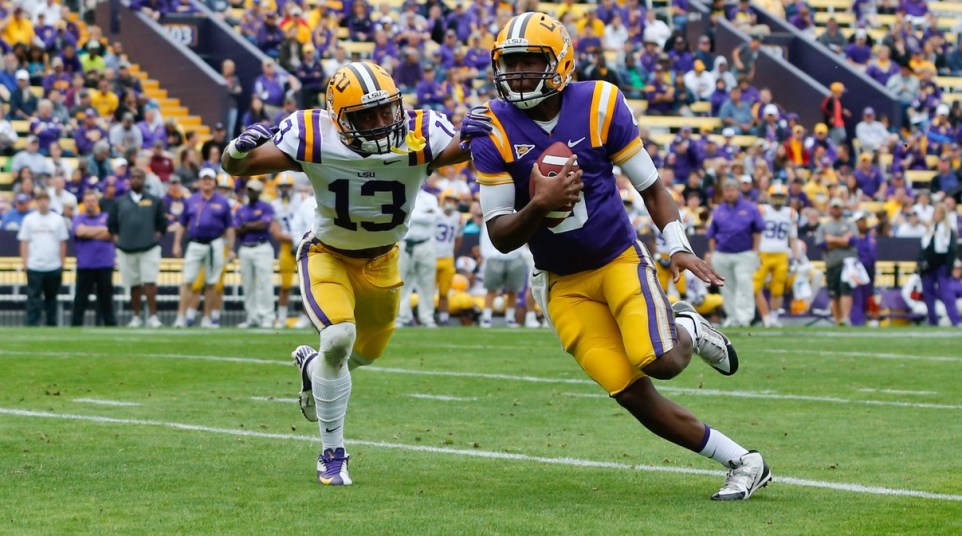Post-spring strengths and weaknesses: LSU
Climbing to the top of the SEC West is no easy task. After sliding down to an 8-5 season in 2014 after four consecutive 10-win campaigns, LSU will look to rebound and contend for a division title this fall.
After nearly two dozen freshmen saw playing time last year, LSU will be counting on a more experienced group to come back strong this fall. Where will the Tigers’ strengths and weaknesses be this fall?
Strengths
- Defensive backfield depth — It’s not common for a team to lose multiple starters from its secondary and still head into the next season perhaps stronger than it was the previous fall. That looks to be the case for LSU, though. Despite the losses of Jalen Collins to the NFL, Ronald Martin to graduation and Rashard Robinson to a dismissal (he may be back with the team in 2016), LSU will have one of the most talented secondaries in the SEC top to bottom. Tre’Davious White returns at one cornerback spot, and he’ll likely have Ed Paris opposite him after the sophomore outplayed early enrollee freshman Kevin Toliver in spring. Jalen Mills is back at safety and will be joined by Jamal Adams and Rickey Jefferson on the back line. Dwayne Thomas returns from injury as well after missing most of last year with an ACL tear. With several talented freshmen coming in, LSU will have the right mix of veteran talent and new blood to have one of the deepest defensive backfields in the nation.
- Offensive line versatility and the run game — LSU is going through a big-time shuffle up front and will have a new full-time starter at all five spots on the line, although several key contributors return from last year’s solid bunch. New left tackle Jerald Hawkins played right tackle last year, while his replacement at RT, Vadal Alexander, was an excellent left guard in 2014. Ethan Pocic, who will play center after coming into the program as a tackle, got plenty of experience at both right guard and center last year. With those three on hand, LSU won’t have anywhere near as much to worry about in case of injury as many of its SEC rivals, possessing a rare ability to move around if need be. Thanks to what should be another excellent offensive line, LSU will once again have no trouble overpowering teams with the running game, something that emergent superstar Leonard Fournette certainly helps with. Even with two freshmen and two sophomores as the ball carriers, LSU will be fearsome on the ground.
- Receiving corps — We’re no closer to finding out if there’s a long-term solution at quarterback for LSU, despite offensive coordinator Cam Cameron’s proclamations that both Anthony Jennings and Brandon Harris were much improved in spring. What we do know is that whoever plays quarterback will have plenty of options to throw the ball to. D.J. Chark was one of the biggest stories of the spring for the Tigers, dominating scrimmages and earning high praise from the coaching staff. Malachi Dupre, who had a promising but inconsistent freshman year, looks primed to have a breakout season after working out of the slot in spring. You can count on all-around improvement from Travin Dural — who will find himself involved in more than just deep routes this fall — an added year of experience for Trey Quinn and John Diarse and another wave of freshmen talent coming in for fall to make receiving group is one of the most dangerous in the conference.
Weaknesses
- Linebacker depth — LSU is going to need its linebackers to not just play well, but also stay healthy this fall; it’s one of the thinnest groups on the team, with just seven scholarship players on the roster. Kendell Beckwith is an emerging SEC beast after taking over the starting role last season, while Lamar Louis, Deion Jones and Duke Riley have all played well, either as a starter (Louis) or in a backup role. After them, Clifton Garrett will be counted on to step up in a big way after not being able to get on the field as a freshman last fall. Kevin Steele reportedly introduced plenty of new wrinkles for the ‘backers this spring, but he’ll have to rely on a smaller group than he’d likely want to have in his first year as DC.
- Quarterback play — Until proven otherwise, LSU is going to be held back by its indecision at quarterback. Last year, Jennings struggled with inaccuracy and indecision, while Harris couldn’t master the playbook or handle the pressures of piloting an SEC offense when he did get on the field. Cameron spoke fairly frequently about how much the two passers have improved since the end of the season, from maturity to playbook mastery, but no one is going to take that too seriously that until there is some tangible on-field evidence, not just a spring romp against backup defenders.
- Defensive end experience — Ed Orgeron was brought in to help bolster a pass rush that wasn’t up to par last fall, and he has more or less a blank slate to work with at defensive end. LSU returns its starting duo at tackle from last year, Davon Godchaux and Christian LaCouture, but both starting ends from last season have moved on. Orgeron will be dealing with a group of new faces to the position; Maquedius Bain and Lewis Neal both played mostly at defensive tackle last fall but are expected to start at DE this year. Backups Tashawn Bower, Deondre Clark and Sione Teuhema all have limited experience, with a combined 2.0 sacks between them. Orgeron is considered a defensive line wizard, but he’ll have to get his troops up to speed quickly.

